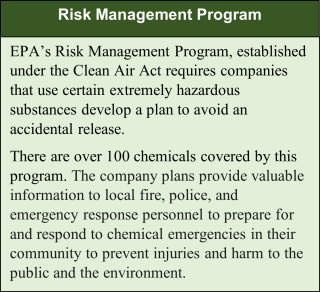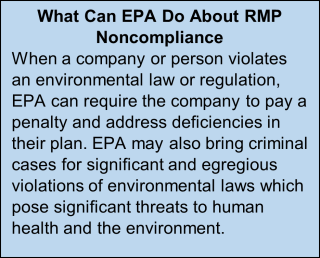EPA Enforcement Activity at the Phillips 66
Spanish Version - Phillip 66 Refinery Information Sheet (pdf)
Tagalog Version - Phillip 66 Refinery Information Sheet (pdf)
Haitian Creole - Phillip 66 Refinery information Sheet (pdf)
The U.S. Environmental Protection Agency (EPA) investigated the Phillips 66 refinery in Carson, California following a 2019 fire at the facility.

On March 15, 2019, the Los Angeles Fire Department was notified of a fire at the Phillips 66 refinery facility in Carson, California. No injuries were reported, and no evacuations took place. California’s South Coast Air Quality Management District took air samples both upwind and downwind of the plant. The sample testing of several air toxics was found to be in the normal range except for butane, a volatile organic compound, which was detected downwind of the facility.
Phillips 66 must follow laws that protect communities by preventing the accidental release of hazardous chemicals. EPA found that the company was not complying with Clean Air Act requirements to ensure that the accidental release of certain hazardous substances does not threaten the health and safety of surrounding communities. The goal of our work is to prevent accidental releases of dangerous chemicals from facilities, such as the Phillips 66 Carson Refinery. This fact sheet provides the Carson community with information about EPA’s enforcement activity related to the facility.
Overview of the Risk Management Program and Plans
Companies that produce, process, handle, or store certain regulated extremely hazardous substances, in quantities above a certain threshold, must develop a risk management plan as required by the Clean Air Act’s Risk Management Program (RMP) rule. The intent of the program is to prevent the accidental release of hazardous substances and make communities safer.

All owners and operators that are required to comply with the rule must implement a risk management program and submit a plan to EPA. The plan must
- Identify (a) the potential effects of a chemical accident and (b) the steps that the company is taking to prevent an accident, and
- Spell out the emergency response procedures should an accident occur.
All risk communication plans are publicly available. After the company develops their facility plan, it is shared with EPA and the local fire and police departments, and other community organizations to prepare for and respond to chemical accidents and foster communication and awareness.
Carson, California residents and community groups can get a copy of the Phillips 66, and any other risk management plans, by visiting a designated federal reading room, or by contacting the California Emergency Response Commission at (916) 845-8754 or the Region 1 Local Emergency Planning Commission at (310) 781-7000. Also, anyone may contact a company or facility owner directly to request the facility's Risk Management Program information, but they are not required under the law to give them to the public. More information about federal reading rooms and risk management plans is available at the end of this document.
Investigation of the Phillips 66 Carson Refinery
Why is EPA Investigating this Refinery?
The Phillips 66 Carson refinery processes crude oil and keeps several flammable chemicals on site. The March 19, 2019, fire occurred following the planned maintenance on a pump and closed down Sepulveda Boulevard, a major road in the Carson community. The inspection on April 15-18, 2019, showed that the pump had a past issue and was vibrating too much during operation. Phillips 66 had previously repaired the pump to fix the vibration issue but did not conduct post-repair testing to make sure the repair fixed the problem. Phillips 66 found that the vibrations caused a part of the pump to fail and resulted in the fire.

How did Phillips 66 not comply with EPA’s Risk Management Program at the Carson Refinery?
EPA found noncompliance with the Risk Management Program requirements at the Carson refinery, indicating that Phillips 66 did not:
- Maintain accurate diagrams and figures for pipes and plant instruments;
- Establish management of change procedures for changes and updates to equipment;
- Update operating procedures after changes were made to the refinery;
- Provide employees with training after changes to parts of the refinery were made;
- Inspect equipment on a regular schedule as recommended by manufacturers and good engineering practices; and
- Correct problems with equipment and continued to use equipment with issues.
What is EPA doing about the noncompliance at the Phillips 66 Carson Refinery?

EPA and the Department of Justice are currently in negotiations with Phillips 66 to reach a settlement agreement to address the noncompliance at the Carson refinery. Phillips 66 has already resolved some of the alleged noncompliance EPA found during its investigation, including correcting and updating certain procedures. The actions we may be able to take for the company’s noncompliance include civil penalties and requirements that the refinery comply with Clean Air Act Section 112(r).
EPA and State Contact Information
If you have questions, comments, or would like to request additional information about the investigation and enforcement activity at the Phillips 66 refinery in Carson, California, please email to EPA at Phillips66case@epa.gov.
Local regulatory agencies:
- Los Angeles Fire Department Health Hazardous Materials Division (HHMD)
- Send email to: AskHHMD@fire.lacounty.gov
- Phone: (323) 890-4045
- South Coast Air Quality Management District contact:
- Send email to: webinquiry@aqmd.gov
- Phone: (909) 396-2000
State regulatory agency:
- California Environmental Protection Agency (CalEPA) California Accidental Release Prevention (CalARP) Program,
- Send email to: CalARP@calepa.ca.gov
Federal Reading Rooms
EPA’s Federal Reading Room for RMPs web page has information on visiting and the location of these rooms across the country. Many states have multiple federal reading rooms, some operated by EPA and others by DOJ.
Information on the reading room near Carson, California, is available from the DOJ Chemical Hazard Information web page.
Learn more about accessing RMP data online.
